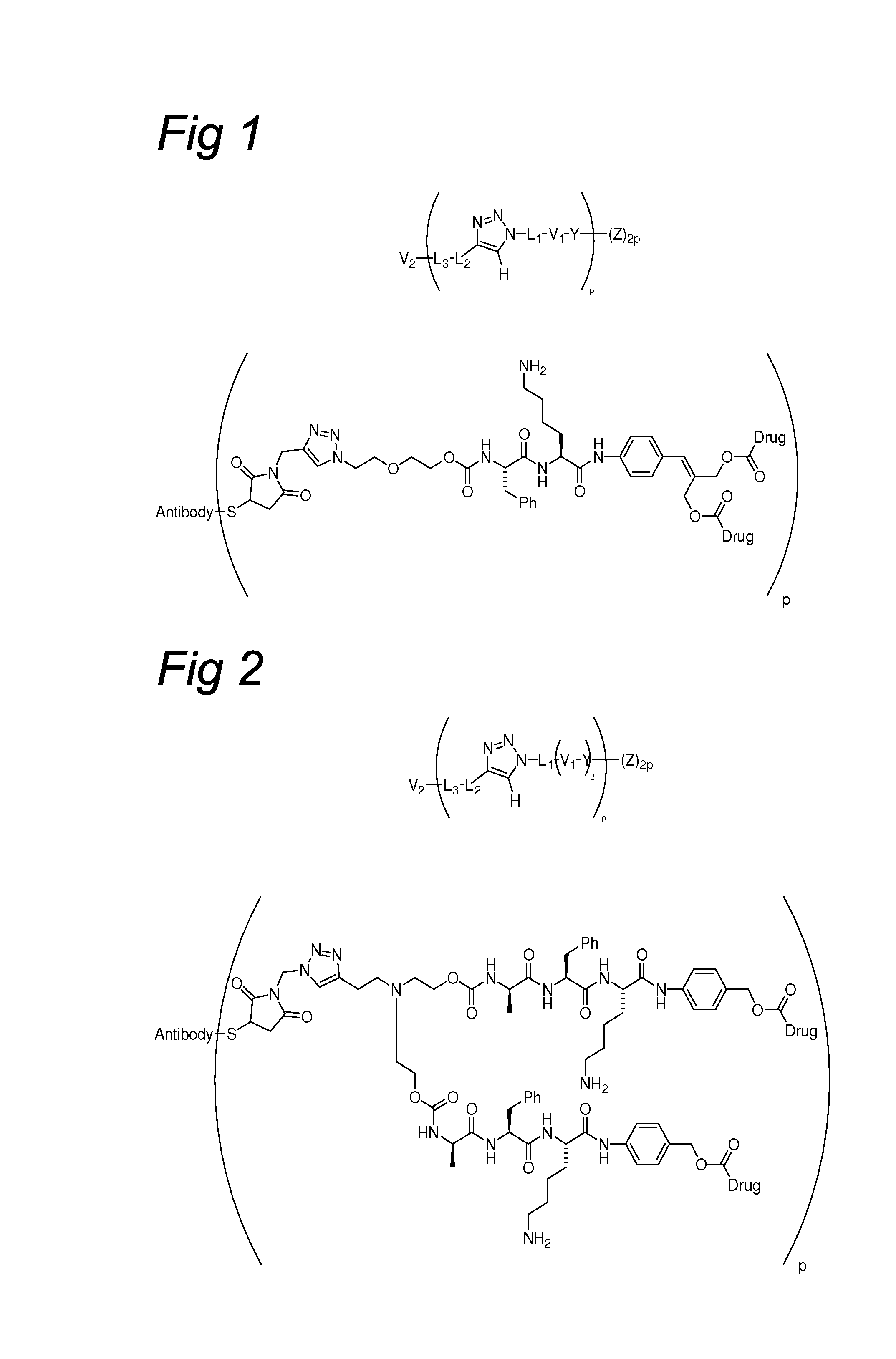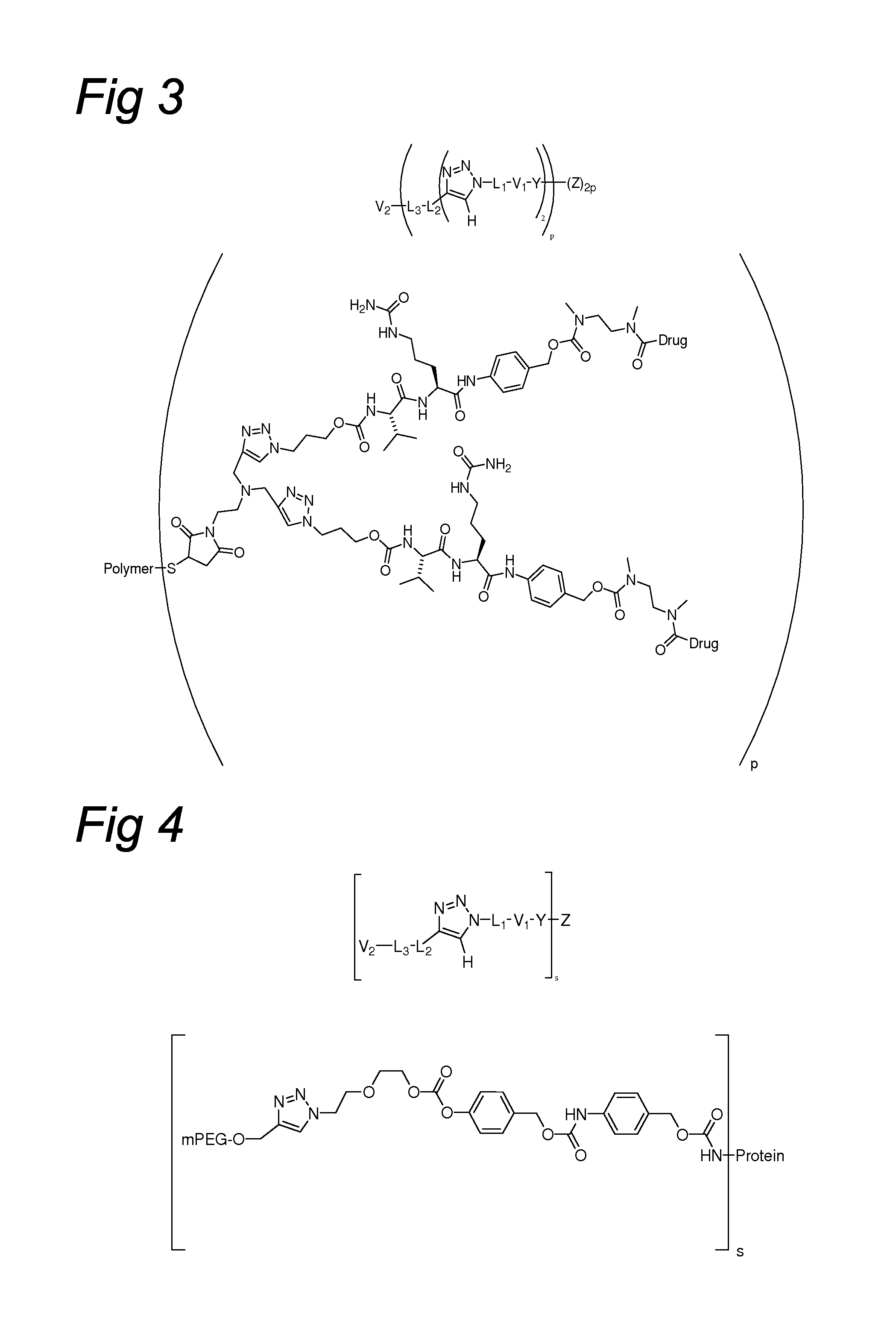Triazole-Containing Releasable Linkers, Conjugates Thereof, and Methods of Preparation
a technology of releasable linkers and triazole, which is applied in the field of triazole-containing releasable linkers, conjugates thereof, and methods of preparation, can solve the problems of inability to achieve drug concentrations that would completely eradicate the tumor, lack of selectivity of chemotherapeutic agents, and associated severe side effects, etc., to achieve the effect of improving the (pharmacokinetic) properties of the compound, less synthetic steps, and easy preparation
- Summary
- Abstract
- Description
- Claims
- Application Information
AI Technical Summary
Benefits of technology
Problems solved by technology
Method used
Image
Examples
example 1
[0386]N-(2-Chloroethyloxycarbonyl)-D-Ala-OH (2): To a solution of NaHCO3 (9.43 g, 112 mmol) and H-D-Ala-OH (2.0 g, 22.5 mmol) in water (110 mL) was slowly added a solution of 2-chloroethyl chloroformate (2.55 mL, 24.7 mmol) in dioxane (100 mL). The reaction mixture was stirred overnight. Dioxane was removed by evaporation and the resulting aqueous solution was acidified with 1 N HCl to pH=3. The solution was extracted three times with ethyl acetate (3×175 mL). The combined organic layers were dried over Na2SO4, filtered, and concentrated to dryness, which gave 2 (4.29 g, 21.9 mmol, 97%) as a viscous oil. 1H NMR (300 MHz, CDCl3) δ: 1.49 ppm (d, 3H, J=7.2 Hz, CH3-Ala), 3.68 (t, 2H, J=5.7 Hz, CH2Cl), 4.32-4.42 (m, 3H, CH2OR+α−H).
example 2
[0387]N-(2-azidoethyloxycarbonyl)-D-Ala-OH (AEC-D-Ala-OH, 3): To a solution of 2 (4.29 g, 21.9 mmol) in DMF (150 mL) was added sodium azide (1.57 g, 24.1 mmol). The reaction mixture was heated and stirred for 48 h. The reaction mixture was then cooled down to room temperature and concentrated to dryness. Chloroform (50 mL) was added to the oily residue and the resulting suspension was filtered. The filter was rinsed with chloroform (2×10 mL), and the combined filtrate was concentrated. After prolonged drying in vacuo crude 3 (5.80 g, max. 21.9 mmol, 100%) was obtained as an oil. 1H NMR (300 MHz, CDCl3) δ: 1.31 (d, 3H, J=6.6 Hz, CH3-Ala), 3.44 (t, 2H, J=5.1 Hz, CH2N3), 4.03-4.22 (m, 3H, α-H+ CH2OR).
example 3
[0388]Fmoc-Phe-Lys(Boc)-OtBu (8): To a suspension of Fmoc-Phe-OH (6, 5.00 g, 12.9 mmol) in dichloromethane (100 mL) were added HOSu (1.56 g, 13.6 mmol) and DCC (2.93 g, 14.2 mmol). The resulting suspension was stirred at room temperature for 3 h. Then, triethylamine (1.83 mL, 13.2 mmol) and H-Lys(Boc)-OtBu.HCl (4.46 g, 13.2 mmol) were added consecutively, and the resulting suspension was stirred overnight. The reaction mixture was filtered, and the filtrate was washed with 10% aqueous citric acid, water, a saturated aqueous NaHCO3 solution, and brine. The organic layer was dried over Na2SO4, filtered, and concentrated. This gave crude 8 (8.97 g, max. 12.91 mmol, 100%) as a white solid. 1H NMR (300 MHz, CDCl3) δ: 1.10-1.90 (m, 6H, CH2-Lys), 1.41 (s, 18H, tBu), 3.01-3.15 (m, 4H, N—CH2-Lys+CH2-Phe), 4.19 (t, 1H, J=6.8 Hz, CH-Fmoc), 4.25-4.55 (m, 4H, 2×α-H+ CH2-Fmoc), 7.19-7.35 (m, 7H, HAr), 7.38 (t, 2H, J=7.4 Hz, HAr), 7.51 (m, 2H, HAr), 7.72 (d, 2H, J=7.5 Hz, HAr).
PUM
| Property | Measurement | Unit |
|---|---|---|
| Composition | aaaaa | aaaaa |
| Therapeutic | aaaaa | aaaaa |
Abstract
Description
Claims
Application Information
 Login to View More
Login to View More - R&D
- Intellectual Property
- Life Sciences
- Materials
- Tech Scout
- Unparalleled Data Quality
- Higher Quality Content
- 60% Fewer Hallucinations
Browse by: Latest US Patents, China's latest patents, Technical Efficacy Thesaurus, Application Domain, Technology Topic, Popular Technical Reports.
© 2025 PatSnap. All rights reserved.Legal|Privacy policy|Modern Slavery Act Transparency Statement|Sitemap|About US| Contact US: help@patsnap.com



